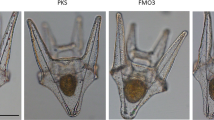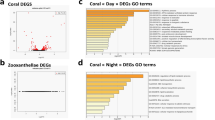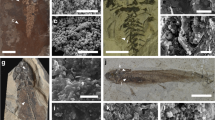Abstract
Haematopoietic stem and progenitor cells (HSPCs) require a specific microenvironment, the haematopoietic niche, which regulates HSPC behaviour1,2. The location of this niche varies across species, but the evolutionary pressures that drive HSPCs to different microenvironments remain unknown. The niche is located in the bone marrow in adult mammals, whereas it is found in other locations in non-mammalian vertebrates, for example, in the kidney marrow in teleost fish. Here we show that a melanocyte umbrella above the kidney marrow protects HSPCs against ultraviolet light in zebrafish. Because mutants that lack melanocytes have normal steady-state haematopoiesis under standard laboratory conditions, we hypothesized that melanocytes above the stem cell niche protect HSPCs against ultraviolet-light-induced DNA damage. Indeed, after ultraviolet-light irradiation, unpigmented larvae show higher levels of DNA damage in HSPCs, as indicated by staining of cyclobutane pyrimidine dimers and have reduced numbers of HSPCs, as shown by cmyb (also known as myb) expression. The umbrella of melanocytes associated with the haematopoietic niche is highly evolutionarily conserved in aquatic animals, including the sea lamprey, a basal vertebrate. During the transition from an aquatic to a terrestrial environment, HSPCs relocated into the bone marrow, which is protected from ultraviolet light by the cortical bone around the marrow. Our studies reveal that melanocytes above the haematopoietic niche protect HSPCs from ultraviolet-light-induced DNA damage in aquatic vertebrates and suggest that during the transition to terrestrial life, ultraviolet light was an evolutionary pressure affecting the location of the haematopoietic niche.
This is a preview of subscription content, access via your institution
Access options
Access Nature and 54 other Nature Portfolio journals
Get Nature+, our best-value online-access subscription
$29.99 / 30 days
cancel any time
Subscribe to this journal
Receive 51 print issues and online access
$199.00 per year
only $3.90 per issue
Buy this article
- Purchase on Springer Link
- Instant access to full article PDF
Prices may be subject to local taxes which are calculated during checkout




Similar content being viewed by others
References
Ding, L. & Morrison, S. J. Haematopoietic stem cells and early lymphoid progenitors occupy distinct bone marrow niches. Nature 495, 231–235 (2013).
Kunisaki, Y. et al. Arteriolar niches maintain haematopoietic stem cell quiescence. Nature 502, 637–643 (2013).
Acar, M. et al. Deep imaging of bone marrow shows non-dividing stem cells are mainly perisinusoidal. Nature 526, 126–130 (2015).
Chen, J. Y. et al. Hoxb5 marks long-term haematopoietic stem cells and reveals a homogenous perivascular niche. Nature 530, 223–227 (2016).
Schofield, R. The relationship between the spleen colony-forming cell and the haemopoietic stem cell. Blood Cells 4, 7–25 (1978).
Horton, J. D. Development and differentiation of vertebrate lymphocytes: review of the Durham symposium — September 1979. Dev. Comp. Immunol. 4, 177–181 (1980).
Tamplin, O. J. et al. Hematopoietic stem cell arrival triggers dynamic remodeling of the perivascular niche. Cell 160, 241–252 (2015).
Murayama, E. et al. Tracing hematopoietic precursor migration to successive hematopoietic organs during zebrafish development. Immunity 25, 963–975 (2006).
Kaidbey, K. H., Agin, P. P., Sayre, R. M. & Kligman, A. M. Photoprotection by melanin—a comparison of black and Caucasian skin. J. Am. Acad. Dermatol. 1, 249–260 (1979).
Azuma, H. et al. Comparison of sensitivity to ultraviolet B irradiation between human lymphocytes and hematopoietic stem cells. Blood 96, 2632–2634 (2000).
Engeszer, R. E., Patterson, L. B., Rao, A. A. & Parichy, D. M. Zebrafish in the wild: a review of natural history and new notes from the field. Zebrafish 4, 21–40 (2007).
Tedetti, M. et al. High penetration of ultraviolet radiation in the south east Pacific waters. Geophys. Res. Lett. 34, L12610 (2007).
Mitchell, D. L., Meador, J. A., Byrom, M. & Walter, R. B. Resolution of UV-induced DNA damage in Xiphophorus fishes. Mar. Biotechnol. 3, S61–S71 (2001).
Osborn, A. R. et al. De novo synthesis of a sunscreen compound in vertebrates. eLife 4, e05919 (2015).
Volff, J.-N. Genome evolution and biodiversity in teleost fish. Heredity 94, 280–294 (2005).
Hurley, I. A. et al. A new time-scale for ray-finned fish evolution. Proc. R. Soc. B 274, 489–498 (2007).
Amemiya, C. T., Saha, N. R. & Zapata, A. Evolution and development of immunological structures in the lamprey. Curr. Opin. Immunol. 19, 535–541 (2007).
Weissman, I. Genetic and histochemical studies on mouse spleen black spots. Nature 215, 315 (1967).
de Abreu Manso, P. P., de Brito-Gitirana, L. & Pelajo-Machado, M. Localization of hematopoietic cells in the bullfrog (Lithobates catesbeianus). Cell Tissue Res. 337, 301–312 (2009).
Akiyoshi, H. & Inoue, A. M. Comparative histological study of hepatic architecture in the three orders amphibian livers. Comp. Hepatol. 11, 2 (2012).
Maslova, M. N. & Tavrovskaia, T. V. [The seasonal dynamics of erythropoiesis in the frog Rana temporaria]. Zh. Evol. Biokhim. Fiziol. 29, 211–214 (1993).
Sanchez, S., Tafforeau, P. & Ahlberg, P. E. The humerus of Eusthenopteron: a puzzling organization presaging the establishment of tetrapod limb bone marrow. Proc. R. Soc. B 281, 20140299 (2014).
Niedźwiedzki, G., Szrek, P., Narkiewicz, K., Narkiewicz, M. & Ahlberg, P. E. Tetrapod trackways from the early Middle Devonian period of Poland. Nature 463, 43–48 (2010).
Markey, M. J. & Marshall, C. R. Terrestrial-style feeding in a very early aquatic tetrapod is supported by evidence from experimental analysis of suture morphology. Proc. Natl Acad. Sci. USA 104, 7134–7138 (2007).
MacIver, M. A., Schmitz, L., Mugan, U., Murphey, T. D. & Mobley, C. D. Massive increase in visual range preceded the origin of terrestrial vertebrates. Proc. Natl Acad. Sci. USA 114, E2375–E2384 (2017).
Westerfield, M. The Zebrafish Book: A Guide for the Laboratory Use of Zebrafish (Danio rerio) 4th edn (University of Oregon Press, Eugene, 2000).
Diep, C. Q. et al. Identification of adult nephron progenitors capable of kidney regeneration in zebrafish. Nature 470, 95–100 (2011).
Curran, K., Raible, D. W. & Lister, J. A. Foxd3 controls melanophore specification in the zebrafish neural crest by regulation of Mitf. Dev. Biol. 332, 408–417 (2009).
Lin, H.-F. et al. Analysis of thrombocyte development in CD41–GFP transgenic zebrafish. Blood 106, 3803–3810 (2005).
Traver, D. et al. Transplantation and in vivo imaging of multilineage engraftment in zebrafish bloodless mutants. Nat. Immunol. 4, 1238–1246 (2003).
Karlsson, J., von Hofsten, J. & Olsson, P.-E. Generating transparent zebrafish: a refined method to improve detection of gene expression during embryonic development. Mar. Biotechnol. 3, 522–527 (2001).
Ema, H. et al. Adult mouse hematopoietic stem cells: purification and single-cell assays. Nat. Protoc. 1, 2979–2987 (2006).
Thisse, C. & Thisse, B. High-resolution in situ hybridization to whole-mount zebrafish embryos. Nat. Protoc. 3, 59–69 (2008).
Gosner, K. L. A simplified table for staging anuran embryos and larvae with notes on identification. Herpetologica 16, 183–190 (1960).
Acknowledgements
We thank D. Richardson at the Harvard Center for Biological Imaging for infrastructure and support; C. MacGillivray at the HSCRB Histology Core and Joyce LaVecchio at the HSCRB Flow Cytometry Core for technical assistance; E. van Italie in M. Kirschner’s laboratory and J. Cech in C. Peichel’s laboratory for providing Xenopus and stickleback samples; the Zebrafish Atlas (http://zfatlas.psu.edu/, NIH grant R24 RR017441, Jake Gittlen Cancer Research Foundation, and PA Tobacco Settlement Fund) for provision of the adult zebrafish histology image. Any use of trade, product or firm names is for descriptive purposes only and does not imply endorsement by the US Government. This work was supported by HHMI and NIH grants 5P01 CA163222, R01 HL048801, P01 HL032262, U54 DK110805-01, R01 DK053298, U01 HL100001-05, and R24 DK092760 to L.I.Z. D.E.F. acknowledges grant support from NIH (5P01 CA163222 and 2R01 AR043369) and the Dr. Miriam and Sheldon G. Adelson Medical Research Foundation. E.J.H. was supported by 1K01DK111790-01. Further support came from the German Research Foundation (DFG-SFB850-A1, to W.D.) and the Excellence Initiative of the German Federal and State Governments (Centre for Biological Signalling Studies EXC 294, to W.D.). F.G.K. was supported by a postdoctoral fellowship of the German Cancer Aid (70110820), a return scholarship of the Forschungskommission, Faculty of Medicine, University of Freiburg, and an EXCEL-Fellowship of the Faculty of Medicine, University of Freiburg, funded by the Else-Kröner-Fresenius-Stiftung. N.S.J. was supported by the Great Lakes Fishery Commission. E.T. was supported by funding from Max Planck Gesellschaft and a Marie Curie Career Integration grant (631432), a Fritz Thyssen Stiftung and the DFG founded Research Training Group GRK2344 ‘MeInBio – BioInMe’. L.A.O. was supported by a Bauer Fellowship from Harvard University. J.M.G. was supported by T32 training grants (T32CA009172-39 and T32HL116324-03).
Reviewer information
Nature thanks I. Beerman, G. Litman and S. Morrison for their contribution to the peer review of this work.
Author information
Authors and Affiliations
Contributions
F.G.K. planned, executed or analysed all experiments. F.G.K. and L.I.Z. wrote the manuscript with input from all authors. J.R.P. and E.T. helped with a subset of in situ experiments, J.M.G. with flow cytometry, E.J.H. with a subset of imaging experiments and L.A.O. created the phylogenetic tree as well as the animal drawings. D.E.S., L.A.O., N.S.J., C.A. and U.W. provided essential materials and samples for the manuscript. W.D., C.M.N., D.E.F. and L.I.Z. supervised the project and gave input to experimental design. All authors discussed the results and commented on the manuscript.
Corresponding author
Ethics declarations
Competing interests
L.I.Z. is a founder and stockholder of Fate Therapeutics, Inc., Scholar Rock and Camp4 Therapeutics. D.E.F. has a financial interest in Soltego, Inc., a company developing SIK inhibitors for topical skin darkening treatments that might be used for a broad set of human applications. The interests of D.E.F. were reviewed and are managed by Massachusetts General Hospital and Partners HealthCare in accordance with their conflict of interest policies.
Additional information
Publisher’s note: Springer Nature remains neutral with regard to jurisdictional claims in published maps and institutional affiliations.
Extended data figures and tables
Extended Data Fig. 1 Melanocytes are spatially associated with the zebrafish kidney but dispensable for steady-state haematopoiesis.
a, Top right panel, schematic of an embryo. The black boxed area contains the kidney and is enlarged in the other panels. Left panel containing 4 images, zebrafish positive for Tg(cdh17:GFP) (green, labelling the kidney tubule) and Tg(runx:mcherry) (red, labelling HSPCs) are depicted at 7 dpf. The boxed areas in the left images are enlarged in the corresponding fluorescence panels in the middle; these panels show the head kidney containing the haematopoietic marrow (indicated by the dashed outline). The white arrow highlights the melanocyte umbrella. Scale bars,100 μm (bright field) and 50 μm (fluorescence). Bottom right panels, the kidney marrow of a 6-dpf larva positive for Tg(mitfa:GFP) (green, labelling melanocytes) and Tg(runx:mcherry) (red, labelling HSPCs) is shown from a lateral view (bottom right, large panel) and from an orthogonal view (transverse section; bottom right, small panel). The scale bar represents 20 μm. b, Whole-mount in situ hybridization of cmyb at different time points, a representative larva at 5 dpf is shown. Arrows indicate (from cranial to caudal) the thymus, the kidney and the caudal haematopoietic tissue; the enlarged portion of the image (dashed box) shows the thymus and the kidney. The experiment was performed with n = 10 wild-type and 10 mitfa−/− larvae at 5 dpf and 10 wild-type and 7 mitfa−/− larvae at 7.5 dpf. c, Flow cytometric analysis of the percentage of HSPCs that were positive for Tg(runx:mCherry) as a proportion of live cells in the kidney marrow of adult fish. Data are mean ± s.d.; n.s., not significant. d–f, Relative abundance of progenitors, myelomonocytes and lymphocytes in adult wild-type fish and mitfa, roy−/− and casper−/− pigment mutants as assessed by flow cytometry as previously described30. c–f, n = 6 wild-type, 6 mitfa−/−, 3 roy−/− and 4 casper−/− fish. Data are mean ± s.d.; analysis by ANOVA.
Extended Data Fig. 2 Unprotected haematopoietic cells accumulate DNA damage after UV irradiation.
a, Sorted cells that were positive for Tg(runx:mCherry) after anti-CPD immunostaining. Scale bars, 10 μm. b, Dot plot representation of data in Fig. 2b (quantification of immunostaining intensity per cell). Data are mean ± s.d.; for statistics and P values please refer to Fig. 2b. c, Magnification of the thymus (dashed red outline) after anti-CPD immunostaining (counterstaining with haemalum) after UVB irradiation at 5 dpf in pigmented and non-pigmented larvae. Arrows from above indicate melanocytes; arrows from below indicate examples of nuclei with DNA damage.
Extended Data Fig. 3 UV light is detrimental to exposed haematopoiesis.
a, Experimental layout. b, Reduction in HSPCs in larvae with and without PTU treatment as assessed by cmyb in situ hybridization after UVC irradiation. n = 26, 26, 24 and 19 larvae in from left to right. χ2 test. c, Reduction in HSPCs in tyr−/− larvae and their pigmented siblings as assessed by cmyb in situ hybridization after UVB irradiation at a UV index of 20. n = 38, 33, 29 and 38 larvae from left to right. Results were not significant but note that the pigmented irradiated group seemed to retain more HSPCs in this experiment than in the preceding experiments with a higher UV index. d, Histology of the kidney marrow two days after irradiation. The yellow outline represents the kidney tubules, the red outline shows the aorta and the green outline indicates the haematopoietic marrow. Note the reduced area of the haematopoietic marrow in the non-pigmented, irradiated larvae (bottom right). Scale bars, 20 μm. e, Abundance of thrombocytes positive for Tg(CD41:GFP) two days after irradiation. Each data point represents the number of thrombocytes per vessel area in individual larvae. n = 8, 7, 7 and 7 larvae for treatment groups from left to right. Statistical significance was calculated using ANOVA with post hoc Bonferroni’s multiple comparison test, data are mean ± s.d. f, Schematic of the analysis of the number of thrombocytes that were positive for Tg(CD41:GFP). The boxed area represents the analysed area, in which the circulating cells were counted. The yellow outline represents the area of the vessel, which the number of circulating thrombocytes was normalized to.
Extended Data Fig. 4 Sunlight exposure in fish living in the wild.
Example of small fish swimming in clear and shallow water on a sunny day (photo taken at Titisee, Germany, July 2016). Field of view approximately 25–30 cm wide.
Extended Data Fig. 5 HSPCs relocated into the bone marrow before the transition to a terrestrial environment.
a, Top, a developmental time line of D. tinctorius. Tadpoles were staged according to Gosner34. Animals (from left to right) represent Gosner stage 25, 30, 41 and 42, as well as a froglet five days after losing its tail. Stage-specific histology analyses are shown in panels b–f as indicated. Bottom, the habitat of D. tinctorius at the different developmental stages. b–f, Haematopoietic niches analysed by haematoxylin and eosin staining. Scale bars, 100 μm (b–f) and 1 cm (a).
Extended Data Fig. 6 Cortical bone protects from UV-induced DNA damage.
a, Paraffin section of a D. tinctorius hind leg (from Extended Data Fig., specimen e) after irradiation with UVB post mortem; the leg was severed from the body and irradiated with UVB. The dashed outline represents the cortical bone. Note the higher staining intensity of the anti-CPD antibody in nuclei within the muscle tissue compared to nuclei within the bone marrow. This part of the leg is not yet haematopoietic (compare to Extended Data Fig. 5e, which shows the haematopoietic marrow in the other leg), but contains chondrocytes. Note that even the chondrocyte nuclei closest to the cortical bone are stained much less than the cells outside the cortical bone (arrows from below and from above, respectively). The triangle represents the direction of the UV source; white tip towards UV source. Scale bar, 50 μm. b, Quantification of grey scale values of nuclei inside (n = 17) and outside (n = 41) the cortical bone. Each data point represents the mean grey value of a 16 × 16 pixel circle inside the nucleus, the difference is highly significant (unpaired Student’s two-tailed t-test, P < 0.0001); data are mean ± s.d.
Extended Data Fig. 7 Experimental setup during irradiation.
Fish were placed in a Petri dish inside the upper cardboard box to focus the light from above, because the Waldmann UV 801 BL unit has a curved lamp carrier. The lower cardboard box was used to place the larvae at the recommended distance from the lamps.
Supplementary information
Supplementary Figure 1.
Flow cytometry gating strategy
Video 1 Melanocytes are spatially associated with kidney marrow HSPCs.
The kidney marrow of a 6 dpf larva positive for Tg(mitfa:GFP) (green, labelling melanocytes) and Tg(runx:mcherry) (red, labelling HSPCs) is shown from a lateral view (left panel). A 360° view was reconstructed using FIJI from the z-stacks
Rights and permissions
About this article
Cite this article
Kapp, F.G., Perlin, J.R., Hagedorn, E.J. et al. Protection from UV light is an evolutionarily conserved feature of the haematopoietic niche. Nature 558, 445–448 (2018). https://doi.org/10.1038/s41586-018-0213-0
Received:
Accepted:
Published:
Issue Date:
DOI: https://doi.org/10.1038/s41586-018-0213-0
This article is cited by
-
Why are haematopoietic stem cells in the bone marrow: ontology recapitulates phylogeny
Leukemia (2023)
-
Effects of the environment on the evolution of the vertebrate urinary tract
Nature Reviews Urology (2023)
-
Propolis inspired sunscreens for efficient UV-protection and skin barrier maintenance
Nano Research (2022)
-
Tissue clearing
Nature Reviews Methods Primers (2021)
-
Knochenmarkveränderungen am kindlichen Skelett
Der Radiologe (2021)
Comments
By submitting a comment you agree to abide by our Terms and Community Guidelines. If you find something abusive or that does not comply with our terms or guidelines please flag it as inappropriate.



